While organic marketing strategies (SEO) can be effective in growing the reach of your practice, most medical professionals still prefer to invest their dollars in PPC campaigns, and for good reason.
Clicks on paid search listings beat out organic clicks by nearly a 2:1 margin.
But that’s not the only reason why PPC ads are so valuable. They also deliver immediate results in the form of traffic, leads, and patients, almost immediately following the launch of the campaign.
Compare that to the months it takes for an SEO campaign to gain traction.
As an Atlanta PPC company with years of experience, we can say with all honesty that pay-per-click campaigns are complex and require planning in order to successfully maximize your quality score (Google’s method of rating the relevance of your ad).
Let’s begin with customer research for your PPC campaign
Before you can launch your ad campaign, you need to know what your patients want, what they’re looking for, and how they’re going about searching for it. This will help you reduce unneeded spending and targeting the wrong people.
Hopefully you have some current patient data to turn to, including buyer personas you may have created in the past.
This data will help you develop your initial keyword seed list, which will be made up of everything you think your patients use to find your services. These are the keywords you want your ad to appear under when your audiences enter them in Google, Bing or any other search engine.
As part of your initial keywords, make sure to include your branded keywords, or the name of your practice, as these have shown to deliver higher conversion rates.
During this step, don’t filter out any relevant ideas. Consider this your brainstorming phase. So long as the keyword has some relevancy, keep it.
Now, check the level of demand for your keywords
With your seed list in place, the next step is to pick out the words that carry the most weight. For that, you need to turn to a keyword tool. Our dental marketing agency department suggests you go straight to the source itself: the Google AdWords Keyword Planner.
This is a really important step. You want to validate the keywords you found by showing the search volume data and trends, cost per click, and competitive data.
Using the Keyword Planner, you’ll also be able to uncover further keyword suggestions.
Seeing as you already have a list of keywords at the ready, use the option that states “Get search volume data and trends.”
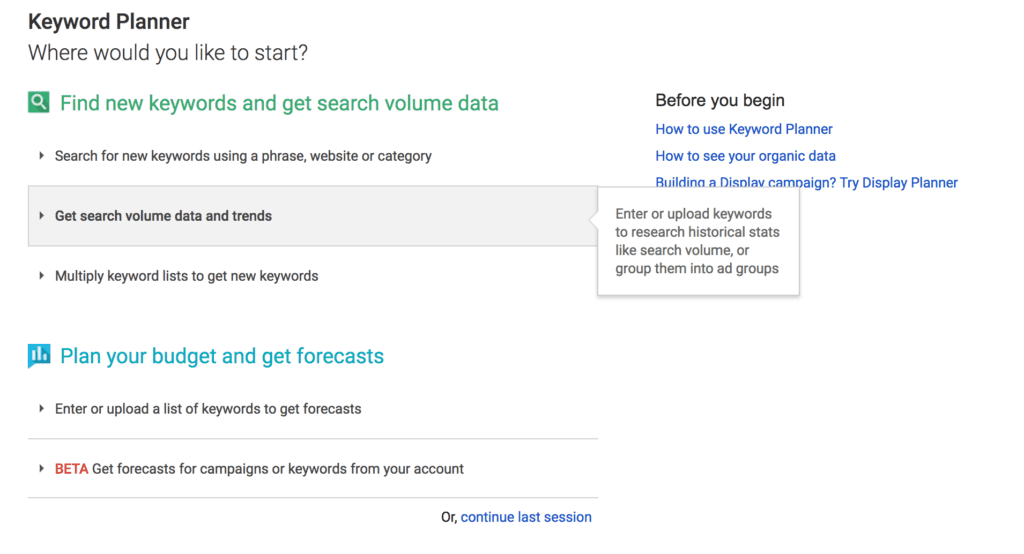
Choosing that will open up a new box, where you can enter in your keywords. Just make sure to set your location to the appropriate setting [global, country/region, state, city, county, etc.]. If you’d like, you can also customize the data range.
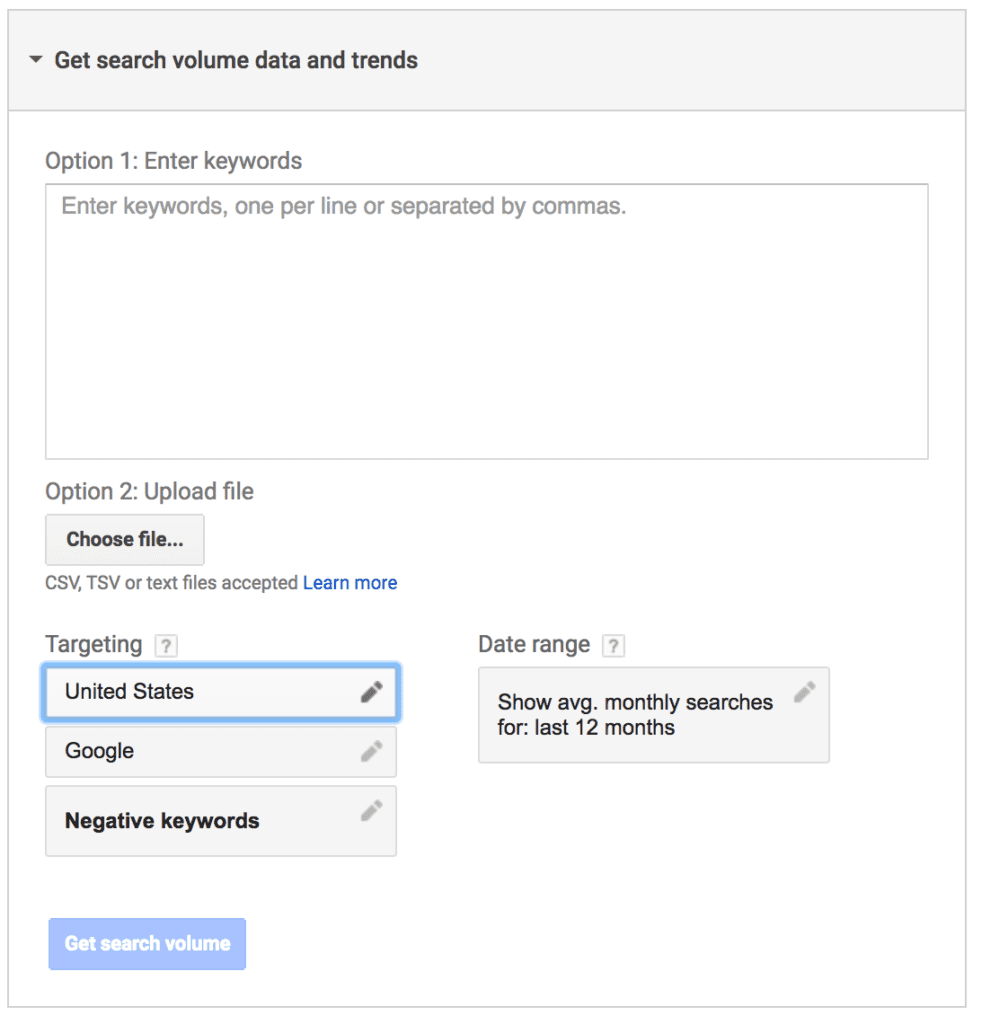
This approach delivers a quick rundown of the quality of your keywords, including providing an average monthly search volume, the suggested bid for your keywords, and any competition for that keyword.
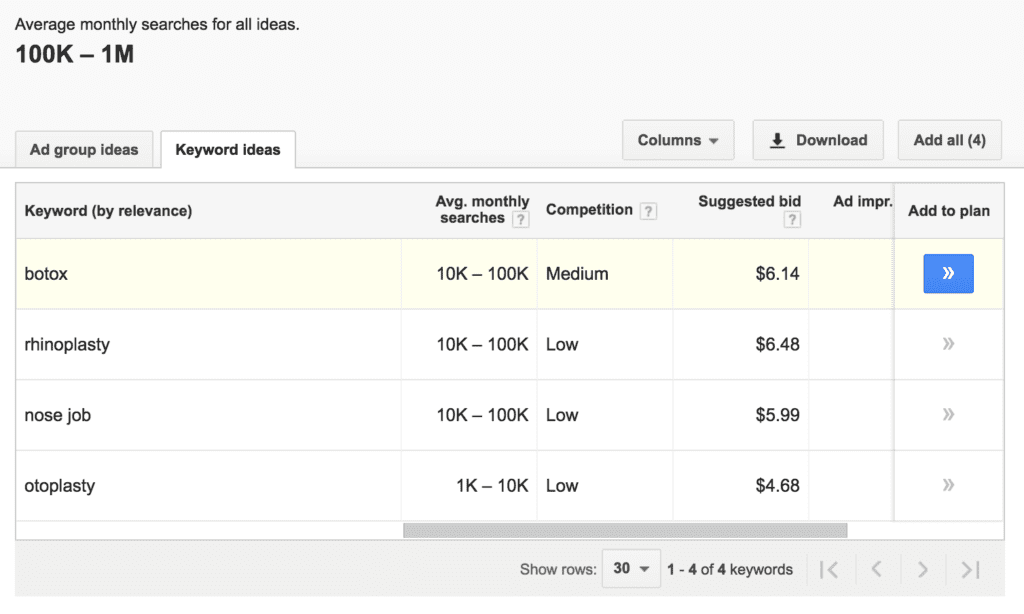
As you run through your list, don’t toss away keywords just yet, even if Google shows that it has low search volume – Google may be able to suggest variations that have better volume.
Time to organize your PPC keywords
Once you know which keywords you plan to use, you want to organize them into more targeted groups of keywords that are related to one another.
For example, you might come up with a table like this:

For brand terms, you’d include the name of your practice. Competitor terms, then, would be the name of your competitors. Generic terms are often the names of your services or procedures, like urgent care, or rhinoplasty. Related terms are keywords that your prospects might use as part of a search looking for your service.
For example, if you’re a plastic surgeon, one of your generic terms might be facelift. But a related term would be fewer wrinkles.
The importance of negative keywords in your initial PPC campaign
You’ve done a good job filling out the table featured above, and think you’re on your way to ad greatness, but not so fast. Just because a keyword has a high search volume, low cost per click, and doesn’t seem to have that much competition, doesn’t mean you should invest in that keyword.
The important factor to consider is intent, and how it relates to your ad.
Let’s say, for example, you run a dental practice and want to create an ad for teeth whitening services. Generic terms like teeth whitening dentist and teeth whitening prices seem logical to target; however, is it really worth your while to target your ad to people searching for how to whiten your teeth on your own?
Sure, these audiences may see your ad and decide to contact your office instead of taking a DIY approach; but isn’t it best to make sure your ad only targets the folks most likely to convert?
That’s where negative keywords come into play.
By flagging certain words or terms, you can improve the relevancy score of your ad by avoiding immediate bounces and lowering the number of ad impressions that result in no clicks.
Research your competitors
Your ads can’t edge out your competition if you don’t know who you’re competing against. There’s an incredible amount of information you can gain from analyzing the PPC campaigns of your biggest competitors. Our healthcare PPC marketing agency uses this strategy.
Using competitive research tools such as SpyFu can reveal details on how other domains are positioning ads:
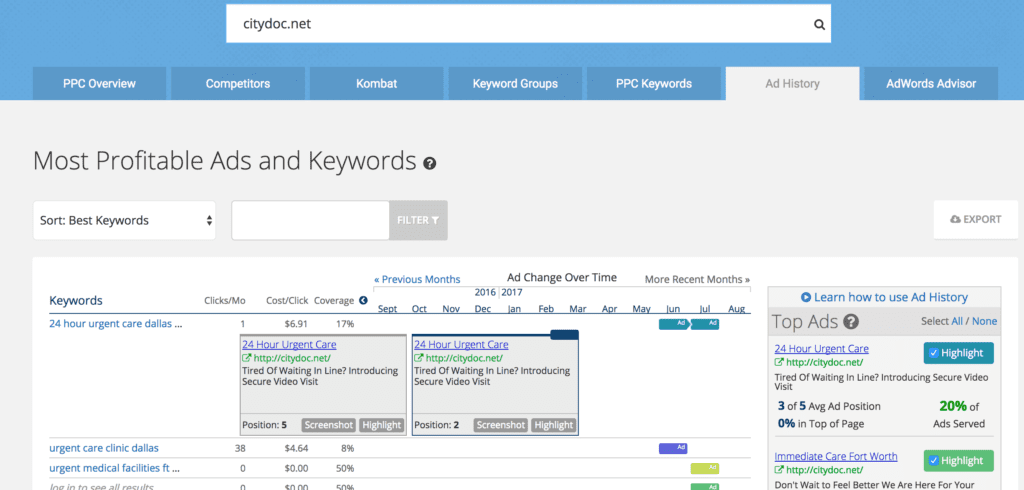
Spending a good amount of time investigating the ad strategies of your competitors can, in the long run, save you an incredible amount of time. If you can find out which keywords they’re profiting from, this minimizes the amount of trial-and-error split testing you have to do on your keywords and ad variations – clearly your competitors have already done the legwork for you.
Write better ad copy
One of the most effective pain management marketing strategies you can implement happens to be one of the least technical, your writing.
With your list of keywords in hand, it’s time to craft the type of copy that will compel your visitors to convert.
The goal here is to find a way to get inside the heads of your prospective patients while promoting something of true value.
Take a look at this group of four ads that popped up for the key phrase fat loss treatments:
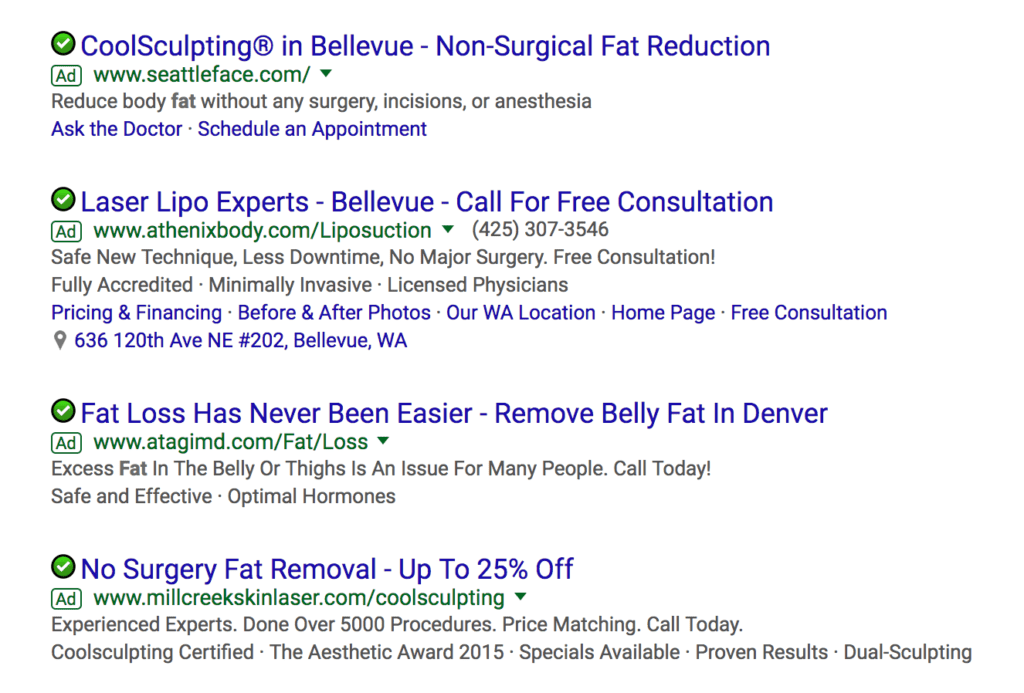
Of these four, three do a pretty good job of offering a value proposition – #1, #3, and #4. #2 (Laser Lipo Experts) does really demand attention. It doesn’t answer the question what’s in it for me. Free consultation? So what? You can get that anywhere.
The other three take different – yet effective – approaches to urge readers to click. 25% off? OK! Fat loss has never been easier? Sign us up. Non-surgical fat reduction? Sure!
Of all three effective ads, however, only one personalizes its value: “Fat Loss Has Never Been Easier – Remove Belly Fat In Denver.”
Personalization is key: a survey conducted by Autopilot shows that online consumers are 4x more likely to respond to personalized offers.
All the research and work you did to understand your prospective patients, as well as their intent, will help you craft the type of ad copy that will lead to more conversions. But keep in mind, you have a limited amount of space in your ad; make every word count.
In that limited space, you have a few key components to work with, including:
- The headline
- Description lines
- Display URL
To make your ad more effective, you want to highlight an irresistible offer, deliver your unique selling proposition, and outline what the user can expect when they click on that ad.
If you don’t have a unique selling proposition (USP) yet, now’s the time to create one. Ask yourself (and your staff) these questions:
- How do you outshine your competitors?
- What makes patients come to your practice?
- What keeps patients coming back?
It’s also worth looking at the USPs of your competitors. If you can find a gap, something patients would value but isn’t being marketed yet, use it to your advantage.
Here are a few other key components to remember with your ad copy:
- Focus more on value than price. The more value you inject in your offer, the more irresistible it will be.
- Remain credible. Avoid creating ad offers that come off sounding too good to be true. Even if it is true, your prospective patients are skeptical of anything that isn’t believable.
- Include keywords. This should be obvious, but is worth stating. Most importantly, make sure your keywords slip into the copy naturally.
Your call to action
Your ads’ call-to-action is the word or phrase designed to get your viewers to act. “Schedule a Free Consult!” “Save 25% off now! “Order online!”
These are all variations of calls-to-action that you may, or may not use in your own PPC ads. So, what makes a good call-to-action?
Interest
A good call-to-action will generate interest from your audience. This goes back to understanding the mindset of your prospective patients, as well as sculpting your CTA around the body of your ad copy.
Clarity
A good call-to-action isn’t hidden behind plastic surgery advertising strategy. Your audience should know exactly what to expect when they click on your ad.
Let’s take a look at four ads from a search of “weight loss treatments”:
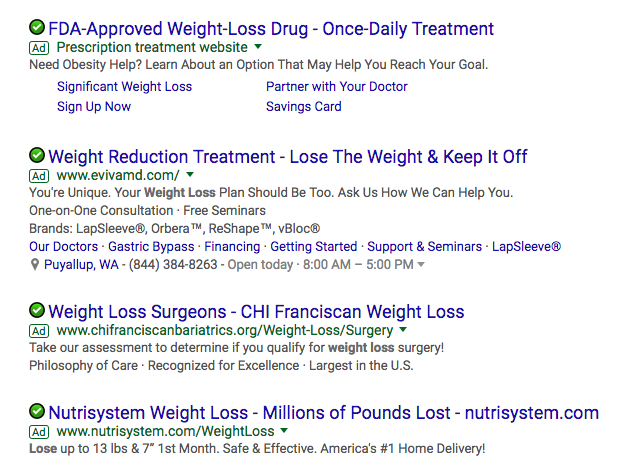
That first ad (“FDA-Approved Weight-Loss Drug”) starts out strong with its title. “FDA-Approved” helps squash any credibility concerns. “Once-Daily Treatment” is certainly a perk. But then look at the body of the ad. “Learn about an option that may help you reach our goal.”
Learn? May?
How incredibly vague. Not only that, but “learn” is associated with effort. No one wants to exert any effort. They want simple, fast answers. That’s why we like ad number four the best: “Lose up to 13 lbs & 7” 1st Month.”
Okay! That call-to-action is telling us what might happen if we click on this ad: We can lose a lot of weight … and fast!
As you develop your CTAs, make sure you avoid vague wording and deliver a promise that makes the reader believe that all of their answers are just one click away.
Finally, use sitelinks
AdWords sitelinks are a feature that allow you to include additional links to pages beyond the landing page of your ad. Take a look at the image below:

Here, the sitelinks are “Non-Surgical Procedures” and “Advanced Laser Treatments.”
So, why would you want to use them?
- They make your ad even larger
- You can highlight certain benefits or features
- You can funnel traffic to specific areas they’re more interested in (with the example above, some of this plastic surgeon’s prospects might be heavily interested in non-surgical procedures, while others are very interested in the latest in laser treatments)
Sitelinks can help you improve your click-through rate, which in turn will improve your Quality Score, while also allowing you to create different experiences for each of your searches.
Setting up sitelinks is extremely easy, by simply going to the ad extensions area of your account, viewing the sitelink extensions dashboard, and then clicking on + New extension.
Your ads will only show sitelinks for queries where Google deems your ad as highly relevant (in other words, you already have a high click-through rate for that query).
If your sitelinks aren’t showing, then it’s likely because they aren’t considered authoritative or relevant enough.
How do you improve your chances of getting your sitelinks to appear on relevant searches?
Aside from understanding patient-prospect behavior, you want to test out different options and implement proper tracking strategies for your mental health marketing campaign, so you can closely monitor all results and make changes as needed.
PPC ads are proven to work for professionals in the medical field
But, if your addiction treatment marketing strategy is ill-conceived or missing key features, you’ll likely hemorrhage money and walk away without any true growth. Follow our digital marketing tips above to get started on the right foot, and discover just how effective a paid strategy can be for your practice.

